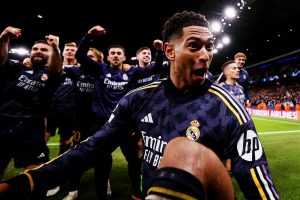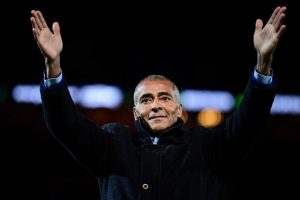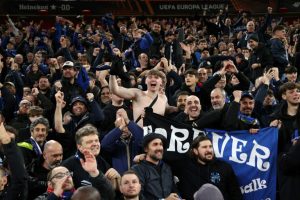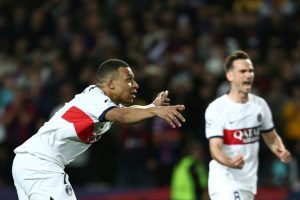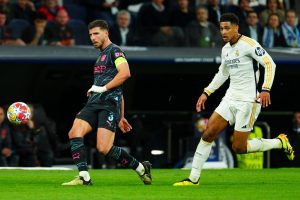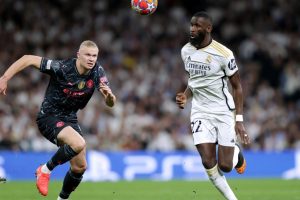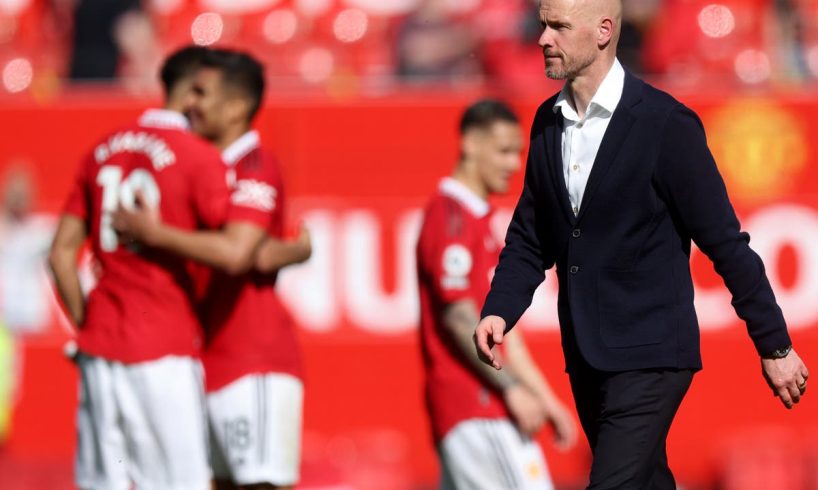
Sign up to Miguel Delaney’s Reading the Game newsletter sent straight to your inbox for free
Sign up to Miguel’s Delaney’s free weekly newsletter
A few months ago, Manchester United felt this summer would be quieter than last. They purchased five players in their first transfer window under Erik ten Hag. The aim was for a mere three major buys this year. They ended up adding four players on deadline day. They made more signings than in 2022. Typical United, always needing more players?
Perhaps. But it is an indication plans can change. Sergio Reguilon, the fifth player through the door, could be seen as Tottenham’s fifth-choice left-back or a former Atletico and Real Madrid defender who was an astute recruit, given the lack of time and limited funds when Luke Shaw joined Tyrell Malacia on the injury list. Altay Bayindir’s aptitude for the role of Andre Onana’s deputy remains to be seen, but for now United know they have emerged in profit from a trade, selling Dean Henderson for an initial £15m – and when it seemed as though a loan with an option to buy was more likely – and replacing him for £4.3m.
There was a pragmatism and a cost-conscious element to re-signing Jonny Evans, too, acquiring defensive cover on a free transfer. The signing of the 35-year-old, who first played for them in 2007 and was relegated with Leicester last season, nevertheless invited ridicule. It added to the sense United were patching up their squad on the cheap. With a different position, past and profile, Evans could be this window’s Wout Weghorst.
All of which left the last deal of the day to feel like the defining one, for three months of trading to come down to the final few hours. Getting Sofyan Amrabat on loan from Fiorentina brought in the defensive midfielder their first three league games of the campaign underlined they needed.
It seems like a fine piece of negotiating: one of the outstanding players in last year’s World Cup was acquired on loan, albeit for a €10m (£8.6m) fee. It also means United will need to pay €20m plus a further €5m in add-ons to buy him: if United had to advance some of this year’s budget to get Antony last summer, now an option to buy means some of 2024’s funds may have to be spent on the Moroccan. It also suggested that United got their priorities in the wrong order, with a pivotal position left until last and when the budget was drained. But United showed the creativity to get a deal done.
But, to rewind a few months, two major requirements were evident: a centre-forward and a central midfielder. Harry Kane was the most obvious option but United were swift to rule out an offer, factoring in the difficulties of dealing with Tottenham chair Daniel Levy, perhaps realising they could not afford him while splitting their funds three ways, and maybe not expecting the England captain to go to Bayern Munich. Yet if Rasmus Hojlund was designed as the cheaper, younger alternative, United ended up paying £64m, rising to £72m, for potential, not proven performance, and the young Dane arrived injured.
He could debut at Arsenal after the transfer window closed. The feeling at Old Trafford is that Ten Hag got his three major targets, and all relatively early. Yet the combined cost could reach £180m, including add-ons, thus rendering it impossible for United to make a fourth major buy – unless they made more significant sales. As loyal as they were to Scott McTominay and Harry Maguire, they perhaps ought to have done more to usher either or both towards the exit, and they have started the season looking like a team scarcely transformed by hefty investment.
Great Dane? Rasmus Hojlund could make his debut against Arsenal
(Getty)
Each of the three main recruits has confounded expectations: Hojlund when many presumed Kane would come; Mason Mount instead of a more conventional midfielder; Andre Onana when David de Gea was long on the brink of staying. United’s change of heart came at a price – an initial £43m for a player who joined Inter on a free transfer last summer – but at least reflected Ten Hag’s ethos and ended the uneasy compromise with De Gea.
Perhaps there was an ideological element to Mount’s arrival, too, looking to add more attacking incision to the midfield. Yet it was notable that last summer’s principal target, even before Casemiro, was Frenkie de Jong; the initial sense was that United might look for a player, such as Amrabat, who was more comfortable in a deeper role. Instead, the flagship signing has been deployed in a role he rarely occupied for Chelsea.
And so Amrabat came to assume a greater importance. There was something anomalous in his presence in the second group of signings, the end-of-window assortment of loans, free transfers and cut-price deals to fill the gaps in the squad, rather than the expensive figures who were the cornerstones of the recruitment policy. United made a little go a long way in the final 24 hours. With a requirement to keep their net spend to around £120m, they needed to.
Moroccan Sofyan Amrabat was one of the outstanding players in last year’s World Cup
(Getty)
“I think we have done good business,” said Ten Hag, before the signings of Reguilon, Evans and Amrabat were announced, though when he had in effect confirmed the Spaniard’s arrival. The squad now features 12 of his signings.
But the eventual verdict on this summer’s splurge may come down to how three fare: not Onana, given the need to move on from De Gea. But Hojlund, who has to deliver the goals expected of a £72m striker; Mount, who has to justify Ten Hag’s decision to reinvent him; and Amrabat, the coup who could add solidity and has the potential to rescue United’s window. The last of them may be the best.

